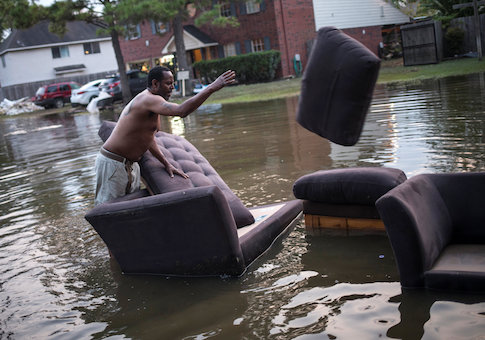By Daniel Trotta
HOUSTON (Reuters) - Authorities lifted an evacuation order for the area surrounding a once-burning chemical plant and a major fuel pipeline reopened on Monday as Texas edged toward recovery from the devastation of Hurricane Harvey.
The storm dumped some 50 inches (125 cm) of rain on the low-lying Gulf coastal region after coming ashore on Aug. 25, killing about 50 people and causing what the Texas governor said could be up to $180 billion in damage.
Flooding led to a series of fires at the Arkema SA chemical plant in Crosby, a town of about 2,300 people some 25 miles (40 km) northeast of Houston. Containers of chemicals which are unstable if not kept refrigerated started igniting on Thursday after power outages cut off cooling systems.
Local firefighters under the watch of the U.S. Environmental Protection Agency and the Texas Commission on Environmental Quality performed a controlled burn of organic peroxides on Sunday to eliminate any vestiges and reduce the danger.
On Monday, the company said the Crosby Fire Department had lifted a 1.5-mile (2.4-km) evacuation zone around the plant, allowing neighbors to return to their homes, and that the company had opened an assistance center to help those affected find temporary housing.
The lifting of the order may help residents like Paul Mincey, a 31-year-old tugboat engineer who has been kept out the ranch home he shares with his girlfriend, return to normal.
"It could be full of snakes for all we know. We have no idea what's in there," Mincey said from aboard a tugboat in the Houston Ship Channel, which he said was polluted by floating railroad ties, trees and trash strewn by the storm.
Like others forced from the evacuation zone, Mincey said he was eager to assess water damage and begin repairs while hoping for financial aid to deal with property damage.
(To view a graphic on Harvey's energy impact, click http://tmsnrt.rs/2xzso1S)
HOW TO PAY?
The question of how to pay for hurricane recovery was also consuming Washington after Texas Governor Greg Abbott on Sunday increased his damage estimate to between $150 billion and $180 billion.
Some 190,000 homes were damaged and another 13,500 destroyed, the Texas Department of Public Safety said on Monday.
At least 33,000 people sought refuge in Texas shelters overnight, with another 1,300 doing so in Louisiana, the American Red Cross said.
Republicans and Democrats returning to Washington after a month-long break will need to put political differences aside in order to approve an aid package. U.S. Treasury Secretary Steven Mnuchin on Sunday challenged Congress to raise the government's debt limit in order to free up relief spending.
The U.S. House of Representatives will vote Wednesday on $7.85 billion in emergency relief funds for the Federal Emergency Management Agency (FEMA) and the Small Business Administration and plans another vote later this month on a separate $6.7 billion sought by President Donald Trump.
In one indication of funding needs, the Texas Department of Public Safety on Monday estimated damage to public property at $382.3 million.
(To view a graphic on Hurricane costs, click http://tmsnrt.rs/2vGkbHS)
ANOTHER HURRICANE BREWING
As the recovery from Harvey picked up speed, Puerto Rico Governor Ricardo Rossello declared a state of emergency and activated the National Guard in preparation for the arrival of Irma, a dangerous Category 3 hurricane.
Irma, which is forecast to strengthen on Tuesday night, is set to hit the U.S. territory on Wednesday, the U.S. National Hurricane Center said.
Current models do not show Irma entering the Gulf of Mexico, where Harvey dealt a major blow to the most important energy hub in the United States, taking up to one-fourth of the country's oil refining capacity offline and driving up fuel prices.
But Colonial Pipeline, the largest American fuel system, said on Monday it would restart a segment of its pipeline in Texas that had been cut off, enabling it to restore the flow distillates such as diesel fuel from Texas to New Jersey.
The gasoline pipeline was due to resume operations on Tuesday, the company said.
Most ports in Texas were open on Monday, some with restrictions on traffic and vessel size, said Colonel Lars Zetterstrom, head of the Army Corps of Engineers' regional office in Galveston.
(To view a graphic on storms in the North Atlantic, click http://tmsnrt.rs/2gcckz5)
(Additional reporting by Barbara Goldberg in New York, Gary McWilliams in Houston and David Shepardson in Washington; Writing by Alistair Bell; Editing by Paul Simao and James Dalgleish)
